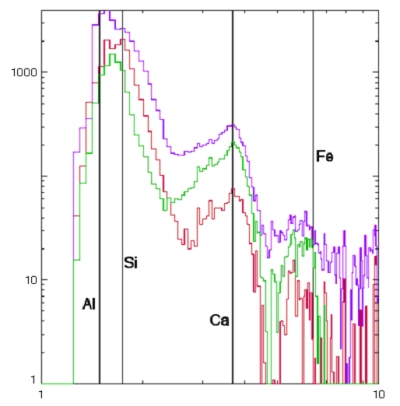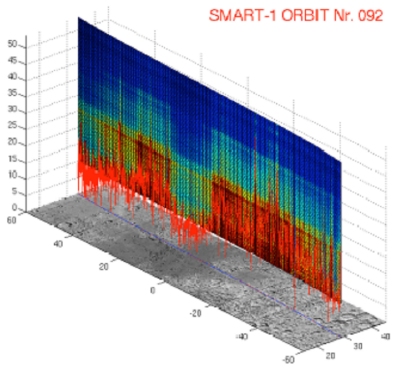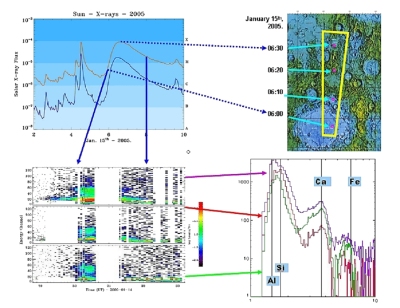Detection of Calcium on the Moon
8 June 2005
During the Lunar commissioning phase, SMART-1's payload already produced interesting science results. Taking advantage of a solar flare, the D-CIXS instrument detected the calcium element on the lunar surface from its X-ray fluoresence.SMART-1 payload commissioning sequences were run in April. As expected the instruments performances are very sensitive to the thermal conditions in Lunar orbit. Therefore specific operating conditions have been arranged to limit the exposure of the panel supporting the SIR and D-CIXS instruments.
These conditions also constrain the downlink pointing to Earth, especially around new moon, as the remote sensing payload are mounted on the opposite side of the spacecraft from the communication medium gain antennas.
Science Results from Lunar commissioning
D-CIXS
Data obtained by D-CIXS during a solar flare allowed for the first time the detection from orbit of the calcium element on the Moon. The operating parameters had to be fine-tuned to adapt to the thermal conditions of the spacecraft and instrument.
 |
|
D-CIXS X-ray spectrum of the Moon. Credit: ESA/D-CIXS |
SIR
Observations of the Moon by SIR made during the commissioning period show differences of infrared reflectance between the highlands and maria.
 |
|
Flux variations recorded by the SIR infrared spectrometer over one orbit at 30 degrees longitude East, showing differences of infrared reflectance between highlands and maria. In particular note the large drop corresponding to Mare Tranquillitatis from 0 to 20 degrees North. Credit: ESA/SMART-1/Max Planck Society. |
In addition, the SIR experiment has conducted a pointing of Jupiter to refine the wavelength calibration.
Presentations
The first results obtained at the Moon have been presented at several international conferences, including:
- Lunar Planetary Science Conference in Houston (14-18 March)
- Lunar session at European Geoscience in Vienna (on 28 April and at a press briefing on 25 April), including a SMART-1 science and technology working team meeting
- Lunar Science Conference: "the Next Decade" in Bad Honnef, Germany (6-10 June 2005)
The following specific instrument science team meetings took place over the last seven weeks:
- SMART-1 plasma working group at ESTEC (22 April)
- D-CIXS at Rutherford Appleton Lab (16-17 May)
- AMIE science team at Toulouse Observatory Midi-Pyrenees (24-25 May)
Contact
Prof. Manuel Grande, SMART-1 D-CIXS Principal Investigator
CCLRC, Rutherford Appleton Laboratory
Tel: 01235 446501
e-mail: M.Grande rl.ac.uk
rl.ac.uk
Bernard H. Foing, ESA - SMART-1 Project scientist
Tel: + 31 71 565 5647
e-mail: bernard.foing esa.int
esa.int

